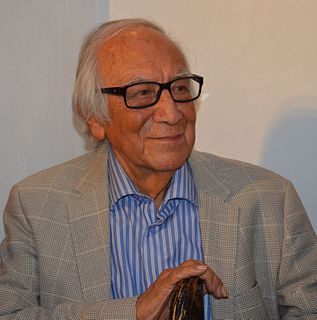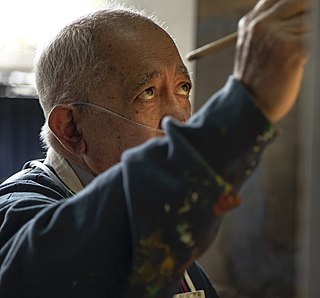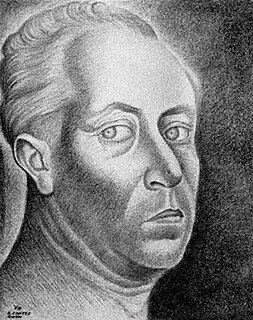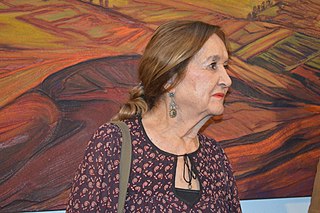
Arturo García Bustos was a Mexican painter and print maker. He is known as one of “Los Fridos” students who studied under Frida Kahlo at her home in Coyoacán.

The Faculty of Arts and Design, is a college of art in Xochimilco, Mexico City. The school is part the Universidad Nacional Autónoma de México, and is responsible for teaching painting, sculpture and graphic design, with undergraduate and graduate studies in San Carlos. It is regarded as one of the best art schools in Mexico.

José Chávez Morado was a Mexican artist who was associated with the Mexican muralism movement of the 20th century. His generation followed that of Diego Rivera, José Clemente Orozco and David Alfaro Siqueiros. Although Chávez Morado took classes in California and Mexico, he is considered to be mostly self-taught. He experimented with various materials, and was an early user of Italian mosaic in monumental works. His major works include murals at the Ciudad Universitaria, Secretaría de Comunicaciones y Transportes and Museo Nacional de Antropología in Mexico City as well as frescos at the Alhóndiga de Granaditas, which took twelve years to paint. From the 1940s on, he also worked as a cultural promoter, establishing a number of cultural institutions especially in his home state of Guanajuato including the Museo de Arte Olga Costa - José Chávez Morado, named after himself and his wife, artist Olga Costa.
Luis Ortiz Monasterio was a Mexican sculptor noted for his monumental works such as the Monumento a la Madre and the Nezahualcoyotl Fountain in Chapultepec Park. His work was recognized in 1967 with the Premio Nacional de Artes and was a founding member of the Academia de Artes.
Amador Lugo Guadarrama was a Mexican painter, graphic artist, writer and cultural promoter, best known for his landscape painting and the founding of several cultural institutions. He began painting when still a child, attending the Escuela al Aire Libre de Pintura in Taxco then developing his career in Mexico City. At that time, the Mexican muralism school was still dominant. Lugo related to its aesthetics but not so much to its politics, so he participated in the founding of various institutions such as the Sociedad Mexicana de Grabadores and the Salón de la Plástica Mexicana which provided opportunities for artists outside the dominant movement. He also worked as an educator, writer and cultural promoter, mostly in Mexico City and his home state of Guerrero.
Francisco Díaz de León was a Mexican graphic artist, notable for pioneering much of modern Mexican graphic arts. He spent his childhood around books and when he studied art in Mexico City, he specialized in engraving and illustration. He spent his career illustrating books, magazines and more, reviving techniques such as dry point and introducing new techniques and styles such as the use of color and linoleum printing. He was also a noted arts education, directing several schools including the Escuela Mexicana de las Artes del Libro, which he founded. He was a founding member of the Academia de Artes and a member of the Salón de la Plástica Mexicana. In 1969 he received the Premio Nacional de Artes for engraving.

Arturo Estrada Hernández is a Mexican painter, one of a group of Frida Kahlo’s students called “Los Fridos.” Estrada is mostly known for his mural work, which remains faithful to the figurative style and ideology of Mexican muralism. He has created murals in various parts of Mexico in both public and private places, including a 1988 mural found in the Centro Médico metro station in Mexico City. He has also taught classes at the Escuela Nacional de Pintura, Escultura y Grabado "La Esmeralda", where he was a student, since 1948 and continues to give classes there and other venues. He lives in his birthplace: Panindicuaro, Michoacán.

Barrio Chino is a neighborhood located in the downtown area of Mexico City, near the Palacio de Bellas Artes. The neighborhood is located on two blocks of Dolores Street and consists of a number of restaurants and businesses that import goods. The neighborhood consists of approximately 3,000 families with Chinese heritage in Mexico City.

Gilberto Aceves Navarro was a Mexican painter and sculptor and a professor at the Escuela Nacional de Artes Plásticas and Academy of San Carlos. There have been more than two hundred individual exhibits of his work, with his murals found in Mexico, Japan and the United States. He received numerous awards for his work including grants as a Creador Artístico of the Sistema Nacional de Creadores de Arte, Premio Nacional de Ciencias y Artes and Bellas Artes Medal from the Instituto Nacional de Bellas Artes.

Alfredo Zalce Torres was a Mexican artist and contemporary of Diego Rivera, David Siqueiros and other better-known muralists. He worked principally as a painter, sculptor, and engraver, also taught, and was involved in the foundation of a number of institutions of culture and education. He is perhaps best known for his mural painting, typically imbued with "fervent social criticism". He is acclaimed as the first artist to borrow the traditional material of coloured cement as the medium for a "modern work of art". Publicity-shy, he is said to have turned down Mexico's Premio Nacional de Ciencias y Artes before finally accepting it in 2001. Before his death, Sotheby's described him as "the most important living Mexican artist up to date".
Ángel Bracho was a Mexican engraver and painter who is best known for his politically themed work associated with the Taller de Gráfica Popular; however he painted a number of notable murals as well. Bracho was from a lower-class family and worked a number of menial jobs before taking night classes for workers at the Escuela Nacional de Artes Plásticas. Even though he had only four years of primary school, he then studied as a full-time student at the university. His art career began working with Diego Rivera on the painting of the Abelardo L. Rodríguez market in Mexico City. He was a founding member of the Taller de Gráfica Popular, making posters that would become characteristic of the group. His graphic design work is simple, clean and fine dealing with themes related to social struggles with farm workers, laborers and Mexican landscapes.
Nicolás Moreno was a Mexican landscape painter, considered to be one of the best of this genre of the 20th century, as well as heir to the Mexican tradition of José María Velasco and Dr. Atl. Although he was born in Mexico City in 1923, he had early contact with nature, traveling with his grandfather and living briefly in Celaya, Guanajuato. He studied art at the country’s Escuela Nacional de Artes Plásticas but was temporarily discouraged when he was told that landscape painting was a “minor genre.” His work almost completely focuses on the varied landscapes of Mexico, mostly to document it, including environmental degradation. His landscape work includes that which appeared in over 100 individual exhibitions in Mexico and abroad as well as a number of important murals including those at the Museo Nacional de Antropología.

Fernando Leal was one of the first painters to participate in the Mexican muralism movement starting in the 1920s. After seeing one of his paintings, Secretary of Education José Vasconcelos invited Leal to paint at the Escuela Nacional Preparatoria. The resulting work is Los danzantes de Chalma. Leal also painted a mural dedicated to Simón Bolívar at the Anfiteatro Bolivar, as well as religious murals such as those at the chapel dedicated to the Virgin of Guadalupe at the Basilica Villa in Tepeyac.

Adolfo Mexiac was a Mexican graphic artist, known principally for his politically and socially themed work, especially with the Taller de Gráfica Popular and with fellow graphic artist Leopoldo Méndez. He also painted several murals, the most important of which deals with the history of human law at the University of Colima. In 2011, a “national homage” was held for the artist at the Museo de la Estampa in Mexico City.

Pablo Kubli is a Mexican sculptor specializing in metals, a member of Mexico’s Salón de la Plástica Mexicana. He initially trained in law and public administration in college, completing bachelor’s and master’s in visual arts later in life. He has one doctorate from the Universidad Politecnica de Valencia, Spain. He's been exhibiting individually since 1991, with most of his works consisting of steel plates and other pieces assembled with nuts and bolts with both organic and geometric forms.
Ofelia Márquez Huitzil is a Mexican artist and member of the Salón de la Plástica Mexicana. She is best known for her abstract art with figurative elements, which has made her work somewhat controversial and excluded from Mexico abstract art movement.

Erasto Cortés Juárez was a Mexican artist and a founding member of the Salón de la Plástica Mexicana.

Rina Lazo Wasem was a Guatemalan-Mexican painter. She began her career in mural painting with Diego Rivera as his assistant. She worked with him from 1947 until his death in 1957 on projects both in Mexico and Guatemala. Thereafter, she remained an active painter, better known for her mural works than canvases, although the latter have been exhibited in Mexico and other countries. This has made her one of Guatemala's best-known artists. She was a member of the Mexican muralism movement and criticized modern artists as too commercial and not committed to social causes. She believed muralism would revive in Mexico because of its historical value.

Pedro Miguel de Cervantes Salvadores was a Mexican sculptor who exhibited in Mexico and abroad and created large monumental works for various locations in the country. Some of his work is noted for its use of used materials such as automobile parts from junkyards. Cervantes received various recognitions for his work including Premio Nacional de Ciencias y Artes in 2011 as well as membership in the Academia de Artes and the Salón de la Plástica Mexicana.

Herlinda Sánchez Laurel was a Mexican artist and art professor at the Universidad Nacional Autónoma de México. Her career has been recognized by membership in the Salón de la Plástica Mexicana, and awards from the state of Baja California, the Palacio de Bellas Artes and the International Coordination of Women in Art among others.













